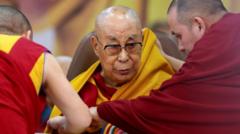As the Dalai Lama prepares to celebrate his 90th birthday on July 6, the Tibetan community in exile grapples with a critical juncture in its history. Since leading thousands out of Tibet to escape persecution nearly seventy years ago, the Dalai Lama has emerged as both a spiritual and political beacon for Tibetans. He established a functioning democracy in the Indian Himalayas, setting up a parliament, bureaucratic systems, and various social services aimed at fostering community among dispersed Tibetan populations.
However, as he marks this significant milestone, the Dalai Lama's advancing age raises concerns for the future of his stateless nation. His physical condition is deteriorating, which brings to light the pressing questions regarding leadership and continuity in the face of China's ongoing efforts to suppress Tibetan autonomy. Tibetans find themselves facing continued exile with uncertain prospects, particularly as global powers, such as the United States, seem to waver in their support.
Within Tibetan enclaves in India, such as Dharamsala—where the Dalai Lama and the Tibetan government-in-exile reside—there’s a palpable anxiety about the implications of his succession plan. The Dalai Lama has promised to reveal this plan soon, potentially exploring creative avenues to safeguard against Chinese influences during this sensitive transition. As Tibetan monks gather in temples for teachings and children learn traditional arts in schools, the heartbeat of their culture persists, but the shadow of an uncertain future looms large over their heads.




















